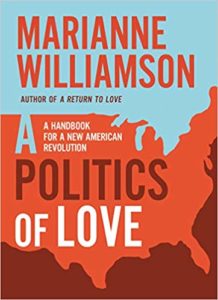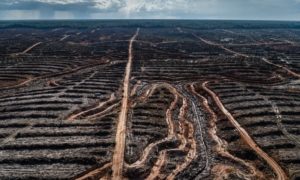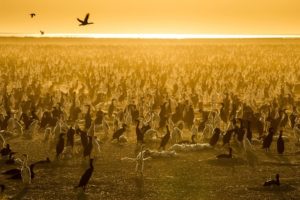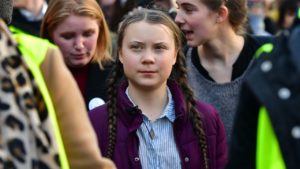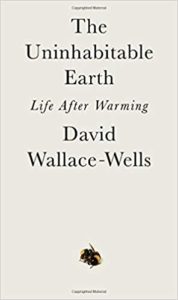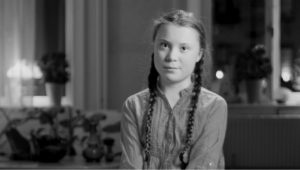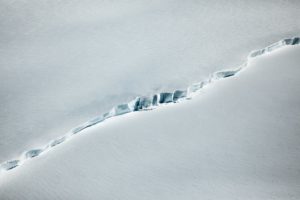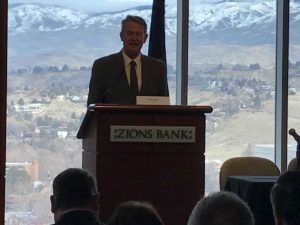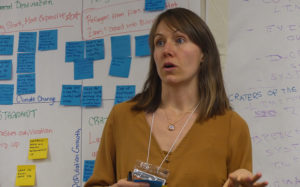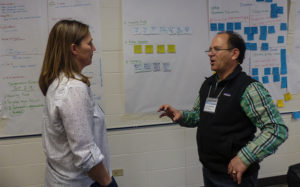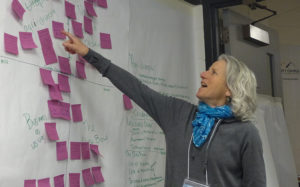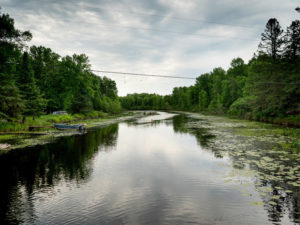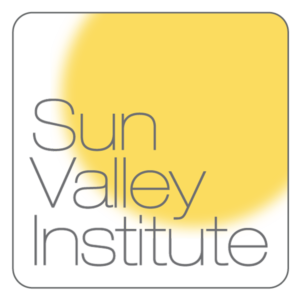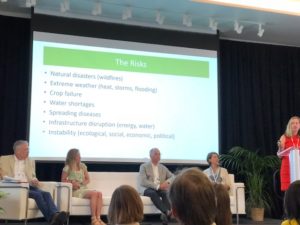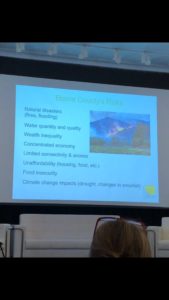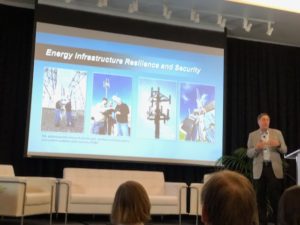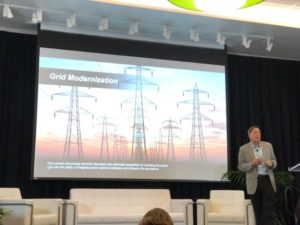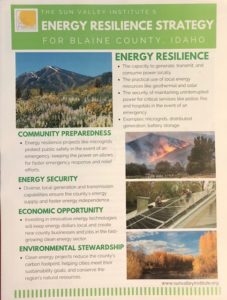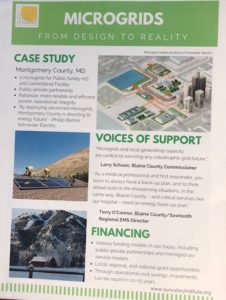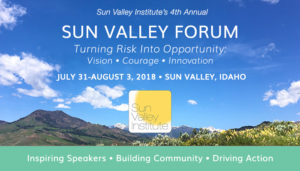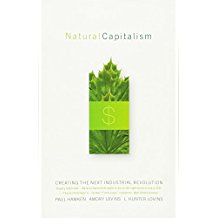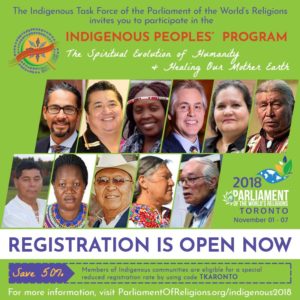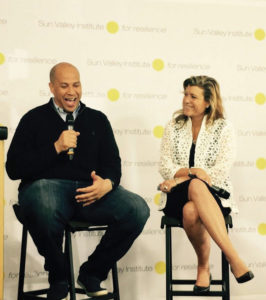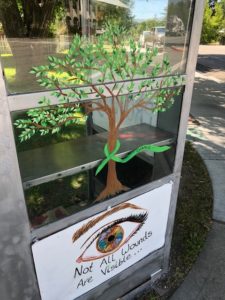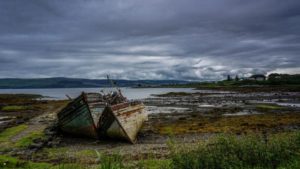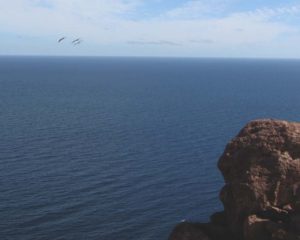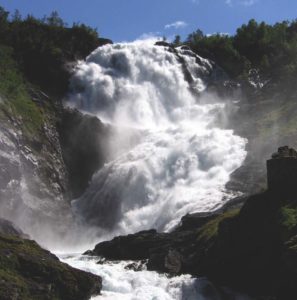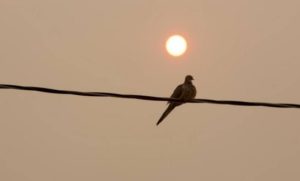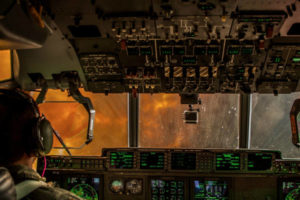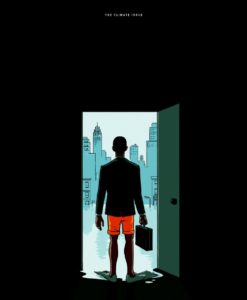Climate Change
The Year Earth Changed
July 26, 2021‘Narrated by David Attenborough, this timely documentary special takes a look at nature’s extraordinary response to a year of global lockdown. This love letter to planet Earth will take you from hearing birdsong in deserted cities for the first time in decades, to witnessing whales communicating in ways never before seen.
Produced by BBC Studios Natural History Unit, directed by Tom Beard, and executive produced by Mike Gunton and Alice Keens-Soper.’
AppleTV+
“One of the first documentary reflections of our strange times.”
Dayle, here. At once heartbreaking and hopeful. Not hopeful in a passive sense, as in ‘some day,’ but now. Together. Living not in dominance over, but interconnection with our planet, our species, all living beings.
Pause.
Reflect.
Our planet is gorgeous, alive, breathing. Pulsing with birth.
And it is burning. We are destroying it in present tense.
Life is being extinguished. We saw how the earth changed in days, weeks, and months early in global lockdowns WITHOUT the interaction of our destructive beings…humans. Carl Jung: “Man won’t deviate the original pattern of his being.” Is this, then, destruction?
We can give permanent pause, space, quiet, and tender mercies in our practices and consciousness, asking, what can I do in my corner of the sky? (Nod to Valarie Kaur.)
We must.
I had so much hope for our planet, for each other, in the early days of this current pandemic, our isolation. It quickly faded when the pause became political, when health and care became virtue signaling, when science became overridden by misinformation, disinformation, and propaganda, hate, disorder, power, and greed.
As a collective human body the focus became on getting ‘back to normal’ instead of shifting to what’s possible. What’s necessary.
We’re on the edge, balancing destruction with possibility. Let’s choose possibility. All of us.
The food we eat.
The cars we drive.
The Energy we use.
The resources we deplete.
The privilege we strive to achieve at the expense of other.
I want to believe there is still time.
And I want to protect all that thrived when we were silent and away.
Let’s give Gaia a chance to live, heal, and breathe. She’s given us so many.
In the silence, did you hear? Did you hear the birdsong? Did you see the animals congregate and communicate? Did you know the whales could hear again? The Himalayas could be seen again?
The future of the natural world is co-existing. We must do the one thing we can do, interconnected, to shift the planet back to health, as we inadvertently did in our absence, the year earth changed.
#
From Maria Popova, sharing a BBC interview with Carl Jung from 1959:
“…the only danger that exists is man himself — he is the great danger, and we are pitifully unaware of it. We know nothing of man — far too little. We are the origin of all coming evil [30:27].”
John Freeman and his team filmed the interview at Jung’s house at Küsnacht (near Zurich, Switzerland) in march 1959, it was broadcast in Great Britain on october 22, 1959. This film has undouptedly brought Jung to more people than any other piece of journalism and any of Jung’s own writings. Freeman was deputy editor at the “New Statesman” at the time of the interview. They formed a friendship, that continued until Jung’s death. -posted by ‘peacefulness’ on YouTube.
Jung: “We need more psychology, more study of human nature.”
We need Gaia’s nature, she does not need us. -dayle
Gaia & Independence
July 4, 2021Another beautiful creation from Jennifer Rose.
Happy 4th.
Remembering this Independence Day post 2020 the United States wasn’t united on the foundation of isolationism or nationalism. Leaders and patriots fought and sacrificed for independence with France who provided the money, troops, armament, military leadership, and naval support that tipped the balance of military power in favor of the United States and paved the way for the Continental Army’s ultimate victory. Spain and the Netherlands helped, too.
And now, as the planet burns, Gaia needs our help. She’s trying. We are not. We must reach across borders and metaphorical walls to pave the way for preservation.
Gaia
December 4, 2020She is so beautiful. We are we still wounding? We know what we’re doing. We must change our collective behaviors. Now. We can do this. We don’t have much time.
Renewal & Reordering
August 26, 2020Image credit: Garden of Wish Fulfilment (detail), Arshile Gorki, 1944, Calouste Gulbenkian Foundation, Lisbon Portugal.
Fr Richard Rohr, Center for Action & Contemplation
- Order
- Disorder
- Reorder
In times of Disorder and deconstruction, we long for Reorder on a personal level—to be made new and whole again. But the Scriptures tell us that restoration will also happen on a communal, planetary, and even universal level! Jim Antal, a climate justice leader with the United Church of Christ, reminds us of our ability and responsibility to participate with God…Gaia…in the renewal and reordering of the earth.
“How can you know all these facts [about climate change] and still have hope?” For me, faith and hope are rooted in the conviction that, regardless of how bad things may be, a new story is waiting to take hold—something we have not yet seen or felt or experienced. . . . God…Gaia…is calling us—as individuals and congregations—to work with God and others to champion that new story.
For the vast majority in our society, that new story remains unseen. Wresting our future from the grip of fossil fuel seems impossible—our addiction is too strong, affordable options are too few, and the powers that defend the status quo are mighty, indeed. . . . We cannot be freed by chipping away at this millstone.
We must begin to live into a new story by changing the human prospect [of destruction] and restoring creation’s viability.
That’s what the Water Protectors of Standing Rock have done. Their courageous, unflinching discipline inspired thousands to join them and millions to imagine with them the new world that is waiting to be born. They prepared themselves through prayer and ritual to face down sheriffs, paramilitary contractors, attack dogs, rubber bullets, pepper spray, and high-pressure water cannons in subzero temperatures. They were fueled by hope, hope for a revolution rooted in love—love for God’s great gift of creation. . . .
We can’t accept God’s…Gaia’s…invitation to help create a new story unless we are willing to take action. We become partners with God when we act in unfamiliar, untested ways. Those new actions will be guided by a preferred future that embraces:
- resilience in place of growth
- collaboration in place of consumption
- wisdom in place of progress
- balance in place of addiction
- moderation in place of excess
- vision in place of convenience
- accountability in place of disregard
- self-giving love in place of self-centered fear . . .
As broken-hearted as God…Gaia…must be over what we have done to the gift of creation, God still has a dream. . . . God dreams that humans seek spiritual rather than material progress. God’s dream envisions a just world at peace because gratitude has dissolved anxiety and generosity has eclipsed greed. God dreams of a time when love and mutual respect will bind humanity together, and the profound beauty of creation will be treasured. Let us embrace God’s…Gaia’s…dream as our own. Suddenly, the horizon of our hope comes nearer.
Center for Action & Contemplation: disconnection and love
May 7, 2019‘I’m convinced that beneath the ugly manifestations of our present evils—political corruption, ecological devastation, warring against one another, hating each other based on race, gender, sexual orientation, religion, or nationality—the greatest dis-ease facing humanity right now is our profound and painful sense of disconnection. We feel disconnected from God, certainly, but also from ourselves (especially our bodies), from each other, and from our world. Our sense of this fourfold isolation is plunging our species into increasingly destructive behavior and much mental illness.
Yet many are discovering that the Infinite Flow of the Trinity—and our practical, felt experience of this gift—offers the utterly grounded reconnectionwith God, with self, with others, and with our world that all spirituality, and arguably, even politics, is aiming for, but which conventional religion and politics fail to access.
Trinity overcomes the foundational philosophical problem of “the One and the Many.” Serious seekers invariably wonder how things can be both deeply connected and yet clearly distinct. In the paradigm of Trinity, we have three autonomous “Persons,” as we call them, who are nevertheless in perfect communion, given and surrendered to each other with an Infinite Love. With the endless diversity in creation, it is clear that God is not at all committed to uniformity but instead desires unity—which is the great work of the Spirit—or diversity overcome by love.
Uniformity is mere conformity and obedience to law and custom; whereas spiritual unity is that very diversity embraced and protected by an infinitely generous love.
This is the problem that our politics and most superficial religion are still unable to resolve.
Trinity is all about relationship and connection. We know the Trinity through experiencing the flow itself, which dissolves our sense of disconnection. The principle of one is lonely; the principle of two is oppositional and moves us toward preference and exclusion; the principle of three is inherently moving, dynamic, and generative. Trinity was made to order to undercut all dualistic thinking. Yet Christianity shelved it for all practical purposes because our dualistic theologies could not process it.
God is not a being among other beings, but rather the Ground of Being itselfwhich then flows through all beings. As Paul says to the intellectuals in Athens, this God “is not far from us, but is the one in whom we live and move and have our being” (Acts 17:27-28). The God whom Jesus reveals is presented as unhindered dialogue, a positive and inclusive flow, and a waterwheel of outpouring love that never stops! St. Bonaventure called God a “fountain fullness” of love.
Our sense of disconnection is only an illusion. Nothing can stop the flow of divine love; we cannot undo the eternal pattern even by our worst sin. God is always winning, and God’s love will finally win in the end. Nothing humans can do can stop the relentless outpouring force that is the divine dance. Love does not lose, nor does God lose. That’s what it means to be God!’
Image credit: (detail), Andrei Rublev, c. 1400-1410, Tretyakov Gallery, Moscow, Russia.
Trinity: The Trinity depicts the three angels who visited Abraham at the Oak of Mamre (Genesis 18: 1-8); the painting is full of symbolism and is interpreted as an icon of the Holy Trinity. At the time of Rublev, the Holy Trinity was the embodiment of spiritual unity, peace, harmony, mutual love and humility.
Marianne Williamson, Democratic Presidential Candidate who bases her platform on love and connection, needs only 2,400 singular donations [$1-$5], 65,000 total, to be allowed to join the first debates schedule for June in Miami. Please donate at https://www.marianne2020.com
“A nation’s behavior is just like an individual’s – either an expression of our higher nature or our lower nature. In the case of both, cause and effect holds: whatever we do has consequences. Love leads to harmony & lovelessness to chaos.That’s why wisdom is relevant to politics.”
Humanity is gravely threatened.
May 6, 2019‘The city we now live will not last.’ [Heb 13:14]
❧
‘Yes, to go forth, hand pulling away from hand.
Go forth to what? To uncertainty,
to a country with no connections to us
and indifferent to the dramas of our life.
What drives you to go forth? Impatience, instinct,
a dark need, the incapacity to understand.
To bow to all this.
To let go-
even if you have to die alone.
Is this the start of a new life?’ -Rilke
❧
‘The pale flowers of the dogwood outside this window are saints. The little yellow flowers that nobody notices on the edge of that road are saints looking up into the face of God.The leaf has its own texture and its own pattern of veins and its own holy shape and the bass and trout hiding in the deep pools of the river are canonized by their beauty and their strength.
The lakes hidden among the hills are saints, and the sea is a saint who praises God without interruption in her majestic dance.
The great, gashed, half-naked mountain is another of God’s natural saints. There is no other like him. He is alone in his own character; nothing else in the world ever did, or ever will, imitate God in quite the same way. That is his sanctity. -Thomas Merton
❧
The Guardian
Human society under urgent threat from loss of Earth’s natural life
Scientists reveal 1 million species at risk of extinction in damning UN report
“Human society is in jeopardy from the accelerating decline of the Earth’s natural life-support systems, the world’s leading scientists have warned, as they announced the results of the most thorough planetary health check ever undertaken.”
The knock-on impacts on humankind, including freshwater shortages and climate instability, are already “ominous” and will worsen without drastic remedial action, the authors said.”
AP
“The research included more than 450 researchers who used 15,000 scientific and government reports.
A new United Nations science report says nature is in trouble and 1 million species of plants and animals are at risk of going extinct. [May 6]
The report’s summary had to be approved by representatives of all 109 nations.
The findings are not just about saving plants and animals, but about preserving a world that’s becoming harder for humans to live in, said Robert Watson, a former top NASA and British scientist who headed the report.
“We are indeed threatening the potential food security, water security, human health and social fabric” of humanity, Watson told The Associated Press.
It’s also an economic and security issue as countries fight over scarcer resources. Watson said the poor in less developed countries bear the greatest burden.”
https://www.youtube.com/watch?v=86oniPiwShc&feature=youtu.be
Gaia
April 13, 2019Will mankind murder Mother Earth or will he redeem her?
-Arnold Toynbee, ‘Mankind and Mother Earth’
Without a global revolution in the sphere of human consciousness, nothing will change for the better in the sphere of our being as humans, and the catastrophe toward which this world is headed…be it ecological, social, demographic, or a general breakdown of civilization…will be unavoidable.
-Václav Havel address to U.S. Congress
Our planet.
The New Yorker
by, Rachel Riederer
With the Netflix Series “Our Planet,” David Attenborough Delivers an Urgent Message
Our Planet is a departure from David Attenborough’s previous documentaries. It places global climate catastrophe front and center, and treats the problems of climate change and habitat loss with a new urgency. “The longer we leave it, the more difficult it will be to solve the problem,” Attenborough, who is ninety-two, told me over the phone from Washington, where he was going to deliver a speech to the International Monetary Fund. “Eventually, of course, you can’t solve the problems, and the result is chaos.”
Greta.
March 18, 2019“I believe the children are our are future, teach them well and let them lead the way.”
16-Year-Old Climate-Strike Leader Greta Thunberg Has Been Nominated for a Nobel Peace Prize
Greta: “Since our leaders are behaving like children, we will have to take the responsibility they should have taken long ago. We have to understand what the older generation has dealt to us, what mess they have created that we have to clean up and live with. We have to make our voices heard.”
The Uninhabitable Earth
March 6, 2019NEW YORK TIMES BESTSELLER
“The Uninhabitable Earth hits you like a comet, with an overflow of insanely lyrical prose about our pending Armageddon.”—Andrew Solomon, author of The Noonday Demon
‘David Wallace-Wells is a national fellow at the New America foundation and a columnist and deputy editor at New York magazine. He was previously the deputy editor of The Paris Review. He lives in New York City.’
“This is only a preview of the changes to come.
And they are coming fast.”
Like An Inconvenient Truth and Silent Spring before it, The Uninhabitable Earth is both a meditation on the devastation we have brought upon ourselves and an impassioned call to action. For just as the world was brought to the brink of catastrophe within the span of a lifetime, the responsibility to avoid it now belongs to a single generation. [Amazon]
An immediate and moral responsibility to engage in this conversation…an entry point being Wallace-Wells’ book & #WITHPod podcast, hosted by Chris Hayes. Here’s the link:
https://art19.com/shows/why-is-this-happening-with-chris-hayes
A young climate activist, Greta Thunberg, in this piece talks about learning the severity of Climate Change, being inspired by Rosa Parks.
Rolling Stone
https://www.rollingstone.com/politics/politics-news/climate-change-greta-thunberg-activist-803631/
Hope within the hopeless.
March 1, 2019Richard Rohr, Center for Action and Contemplation:
“Without a Shared and Big Story, all humans retreat into private individualism for a bit of sanity and safety.
Perhaps lack of attention to the [ancient] Mystery can be seen in the way we continue to pollute and ravage planet Earth, the very thing we all stand on and live from. Science now appears to love and respect physicality more than most religion does! No wonder that science and business have taken over as the major explainers of meaning for most people today (even many who still go to church). Christians did not take this world seriously, I am afraid, because our notion of God or salvation didn’t include or honor the physical universe. And now, I am afraid, the world does not take [this] seriously.
Hope cannot be had by the individual if everything is corporately hopeless.
It is hard to heal individuals when the whole thing is seen as unhealable.”
Just got real in Idaho.
January 16, 2019Little on Climate Change: “It’s a Big Deal”
“Climate change is real,” Little said.“Climate’s changed, there is no question about it,” Little said. “We’ve just gotta figure out how to cope with it and we gotta slow it down. Now, reversing it is going to be a big darn job, if 90 percent of the scientists are right. … The rate of change, we can make a change in. But it’s a big deal.”
“Actually, we can do it by regulation, but a lot of it takes place from the market.” He said, “Bankers are inclined by their very nature to be risk-averse,” and over time, they’ll be more likely to finance something “that’s going to have a smaller carbon footprint, vs. something that’s going to have a bigger carbon footprint.”
“The ultimate solution is we want to have things that keep the air cleaner and produce less carbon,” Little declared.
He noted that back when Idaho did its energy plan, people thought it was a stretch to move Idaho to 20 percent renewable energy not counting hydro, but it happened.
“Climate change is real,” Little said. “I’m old enough that I remember feeding cows all winter long in deep snow, and I go to the ranch now and talk, ‘You wimpy guys, boy, back in the old days when I was a kid, we had winters.’ And there are other things. These ecosystems are changing.”
Little said even the microbes in the soil are changing, altering how they take in oxygen. “So when we do a range project, you’ve got to make that to where it’s changing for a different climate type. The silviculturists will tell you, because of the changing climate, the number of trees, the species of trees, the mix of trees, it’s all changing. … You’ve gotta adapt to it.”
Blaine County Community Resilience Workshop: Climate Change
December 6, 2018Aimee Christensen led a group looking at energy scenarios.
Journalist Karen Bossick published an in-depth exposé today [12.6] on Blaine County’s 1st Community Resilience Workshop. Our valley is the first in Idaho to begin planning for climate changes and the effects those changes will, and are, having in our community, e.g., wild fires, energy sources, food, jobs, and housing. Blaine County Commissioner Larry Schoen: “We’re setting the stage not only for our own action but for other communities to follow our lead.” A second workshop is scheduled for February to begin pursuing concrete actions. The workshop was initiated by the Blaine County Commissioners and organized by the Sun Valley Institute.
Eye On Sun Valley, Story & Photos by Karen Bossick
Brittany Skelton, senior planner for the City of Ketchum, addresses such scenarios where the county might have to kick squatters out of national forest land.
Sawtooth National Forest official Bobbi Filbert and Blaine County Commissioner Jacob Greenberg discuss possible scenarios involving climate refugees.
Hailey City Council Member Kaz Thea points out the need for increased agricultural diversity in the Wood River Valley.
“We’re traveling 10 years into the future so we can move from fear and concern into hope and action,” said Amber Bieg, a facilitator with the Boise-based Warm Springs Consulting.
A Changing Climate/Farmers
August 7, 2018NPR/Morning Edition
Rebecca Hersher
So far there are limited strategies for protecting wild rice harvests. Diverting runoff for slowing down floodwater so it doesn’t destroy plants could help, but rising temperatures may ultimately lead the plant’s range to shrink northward into Canada.
That would be bad news for people who currently harvest wild rice on reservations. “Migration as an adaptation strategy for tribes is not really an option,” says Melonee Montano, who works on traditional ecological knowledge outreach at GLIFWC. “Our land is fixed. All we can do is to work together to improve awareness and look for solutions.”
Climate Change Threatens Midwest’s Wild Rice
A Staple For Native Americans
Full Article:
SVI: Where Convention and Opportunity Meet
Walter Starke:
“The spiritualization of our nation’s corporations is the most important development that can possible happen of the spiritual growth of the world as a whole.
Changing Climate/Climate Change
Visuals from the Sun Valley Forum
RISKS
OPPORTUNITIES
Mark Peters, Director, Idaho National Laboratory (INL)
‘The Idaho National Laboratory’s mission includes discovering, demonstrating and securing innovative clean energy options and critical infrastructure, making it a test bed and model for resilience innovation serving national security, including grid and cyber security and micrograms.’
https://www.inl.gov/article/grid-resilience/
“Last fall, Idaho National Laboratory researchers assembled a coalition of partners to design a system of microgrids that would enhance grid resilience by maintaining and restoring power after a catastrophic event or a cyberattack.
During the coming months, the partners will demonstrate this technology in the small fishing village of Cordova, Alaska.
When the microgrid system is finished, Cordova’s electrical grid will automatically reroute power to ensure that critical public services — hospitals, emergency shelters and other vital services — have electricity if part of the grid is damaged or disabled.”
“Microgrids and local generating capacity are central to surviving any catastrophic grid failure.” -Larry Schoen, Blaine county Commissioner
“As a medical professional and first responder, you learn to always have a back-up plan, and to think ahead even in life-threatening situations. In the same way, blaine county–and critical services like our hospital–need an energy back-up plan.” -Terry O’Connor, Blaine county/Sawtooth Regional EMS Director
SVI: Where Convention and Opportunity Meet
August 3, 2018Initial takeaways from the 2018 Sun Valley Forum:
Re-invent impact.
The media promotes crazy extremes; the changing climate is not a political ideology.
Time is imperative.
“Stop thinking in silos.” -Julie Wrigley
407
Climate Mayors — the national coalition of 407 U.S. Mayors dedicated to pursuing solutions to global warming — denounces this unprecedented attack on both the environment and states’ rights, and vows to continue moving forward on transportation policies that help reduce the impact of climate pollution.
“I promise to leave the world better than I found it.”
The authors of Natural Capitalism say that these choices are possible and such an economy would offer a stunning new set of opportunities for all of society, amounting to no less than the next industrial revolution. The book has many practical suggestions for companies interested in a sustainable future.
According to the authors, the “next industrial revolution” depends on the espousal of four central strategies: “the conservation of resources through more effective manufacturing processes, the reuse of materials as found in natural systems, a change in values from quantity to quality, and investing in natural capital, or restoring and sustaining natural resources.
We win or die by our culture; we are everyday change makers.
#ClimateOptimist
The Climate Optimist Manifesto:
“I believe we can solve climate change.
I will shine a light on solutions, share my optimism & take positive action.”
“There isn’t enough hope–we have to keep hope alive”
“Martin Luther King didn’t say, ‘I have a nightmare.’ He said, ‘I have a dream.'”
BlessedTomorrow.org
Climate Change Mitigation and Advocacy in 2018 and Beyond
by Anita Fete Crews
6.14.18
On May 2, Blessed Tomorrow and Auburn Seminary co-hosted the 2018 National Climate and Faith Leadership Forum, a gathering of nearly 50 faith leaders exploring how to increase climate change mitigation and advocacy activities across the country. Participants represented a diverse group of faith institutions and faith-based organizations, shared best practices, and discussed how to catalyze new, bolder, and broader efforts such as committing to 100% clean energy. Faith organizations and leaders are increasingly adopting climate change as a top priority, and embracing care for God’s creation as part of their faith identity and moral responsibility.
http://blessedtomorrow.org/blog/climate-change-mitigation-and-advocacy-2018-and-beyond
“Vote with your fork.” -Ali Long
“Local Food Alliance…is on and pushing the leading edge of dynamic social and economic changes that are increasingly important in an ever-widening circle of acceptance.” – Larry Schoen, Blaine County Commissioner
Senator Cory Booker (D) spoke with Founding Executive Director Aimee Christensen at the first Sun Valley Forum four years ago. On Friday, August 2nd, at the Netroots National Annual Conference he shared:
“No matter how powerful corporate greed and corporations might be getting, the power of the people is greater than the people in power.”
And this gives us hope.
[More from the forum soon–check this space.]
Climate Change Linked to Suicide Increase
July 27, 2018New research from Stanford University finds that higher temperatures are leading to more suicides. And by 2050, the study predicts, thousands of additional suicides will have occurred in North America alone due to the rising temperatures caused by climate change.
Published in the journal Nature Climate Change, the study examined decades of county-level suicide data — nearly 1.5 million observations spanning all of the United States and Mexico — as well as data that tracked monthly temperatures in each area. The team used data going back as far as 1968.
According to the research, a monthly rise in temperature of 1 degree Celsius leads to “about a 1 to 2 percent increase in the suicide rate,” says Dr. Marshall Burke, assistant professor of earth system science at Stanford University and lead author of the study.
Burke says there is “emerging physiological evidence” that the parts of the brain involved with regulating emotion are also used when dealing with heat. While “there is a plausible link here,” he says, the mechanism linking heat to suicide remains an open question.
“We need a movement in this country, more than anywhere, that makes it unacceptable for political leaders to […] not meet their climate obligations, or to deny that climate change is even a real thing,” he says.
-WBUR, Justin Kaplan
Full article: http://www.wbur.org/commonhealth/2018/07/23/global-warming-deaths-by-suicide
“…surely not alarmed enough.”
February 11, 2018“Complacency is much more dangerous than fatalism.’
New York Magazine:
There’s a lot of scientific debate about the future of climate change. But have you ever considered the worst case scenario? David Wallace-Wells gives us one terrifying glimpse into the future after consulting experts from various fields.
http://nymag.com/daily/intelligencer/2017/07/climate-change-earth-too-hot-for-humans.html
But no matter how well-informed you are, you are surely not alarmed enough. Over the past decades, our culture has gone apocalyptic with zombie movies and Mad Max dystopias, perhaps the collective result of displaced climate anxiety, and yet when it comes to contemplating real-world warming dangers, we suffer from an incredible failure of imagination. The reasons for that are many: the timid language of scientific probabilities, which the climatologist James Hansen once called “scientific reticence” in a paper chastising scientists for editing their own observations so conscientiously that they failed to communicate how dire the threat really was; the fact that the country is dominated by a group of technocrats who believe any problem can be solved and an opposing culture that doesn’t even see warming as a problem worth addressing; the way that climate denialism has made scientists even more cautious in offering speculative warnings; the simple speed of change and, also, its slowness, such that we are only seeing effects now of warming from decades past; our uncertainty about uncertainty, which the climate writer Naomi Oreskes in particular has suggested stops us from preparing as though anything worse than a median outcome were even possible; the way we assume climate change will hit hardest elsewhere, not everywhere; the smallness (two degrees) and largeness (1.8 trillion tons) and abstractness (400 parts per million) of the numbers; the discomfort of considering a problem that is very difficult, if not impossible, to solve; the altogether incomprehensible scale of that problem, which amounts to the prospect of our own annihilation; simple fear. But aversion arising from fear is a form of denial, too.
To The Best of Our Knowledge:
There’s a lot of scientific debate about the future of climate change. But have you ever considered the worst case scenario? David Wallace-Wells gives us one terrifying glimpse into the future after consulting experts from various fields.
https://www.ttbook.org/interview/how-bad-can-climate-change-really-get
And while many people are working to try to counter this imbalance, most are approaching it with the very same mind-set that has created this predicament. Before we can begin to redeem this crisis, we need to go to the root of our present paradigm—our sense of separation from our environment, the lack of awareness that we are all a part of one interdependent living organism that is our planet. This can be traced to the birth of the scientific era in the Age of Enlightenment and the emergence of Newtonian physics, in which humans were seen as separate from the physical world, which in turn was considered as unfeeling matter, a clockwork mechanism whose workings it was our right and duty to understand and control.
While this attitude has given us the developments of science and technology, it has severed us from any relationship to the environment as a living whole of whose cycles we are a part. We have lost and entirely forgotten any spiritual relationship to life and the planet, a central reality to other cultures for millennia.1 Where for indigenous peoples the world was a sacred, interconnected living whole that cares for us and for which we in turn need to care—our Mother the Earth—for our Western culture it became something to exploit.
But there is an even deeper, and somewhat darker, side to our forgetfulness of the sacred within creation. When our monotheistic religions placed God in heaven they banished the many gods and goddesses of the Earth, of its rivers and mountains. We forgot the ancient wisdom contained in our understanding of the sacred in creation—its rhythms, its meaningful magic. For example, when early Christianity banished paganism and cut down its sacred groves, they forgot about nature devas, the powerful spirits and entities within nature, who understand the deeper patterns and properties of the natural world. Now how can we even begin the work of healing the natural world, of clearing out its toxins and pollutants, of bringing it back into balance, if we do not consciously work with these forces within nature?
Nature is not unfeeling matter; it is full of invisible forces with their own intelligence and deep knowing. We need to reacknowledge the existence of the spiritual world within creation if we are even to begin the real work of bringing the world back into balance. Only then can we regain the wisdom of the shamans who understood how to communicate and work together with the spirit world.2
While there may be a growing awareness that the world forms a single living being—what has been called the Gaia principle—we don’t really understand that this being is also nourished by its soul, the anima mundi—or that we are a part of it, part of a much larger living, sacred being. Sadly, we remain cut off, isolated from this spiritual dimension of life itself. We have forgotten how to nourish or be nourished by the soul of the world….3
We cannot return to the simplicity of an indigenous lifestyle, but we can become aware that what we do and how we are at an individual level affects the global environment, both outer and inner. We can learn how to live in a more sustainable way, not to be drawn into unnecessary materialism.
We can also work to heal the spiritual imbalance in the world. Our individual conscious awareness of the sacred within creation reconnects the split between spirit and matter within our own soul and also within the soul of the world: we are part of the spiritual body of the Earth more than we know.
The crisis we face now is dire, but it is also an opportunity for humanity to reclaim its role as guardian of the planet, to take responsibility for the wonder and mystery of this living, sacred world.
Full article:
https://parabola.org/2018/01/10/the-call-of-the-earth-by-llewellyn-vaughan-lee/
THE WIRED GUIDE TO CLIMATE CHANGE
How this Global Climate Shift Got Started
“If we want to go all the way back to the beginning, we could take you to the Industrial Revolution—the point after which climate scientists start to see a global shift in temperature and atmospheric carbon dioxide levels. In the late 1700s, as coal-fired factories started churning out steel and textiles, the United States and other developed nations began pumping out its byproducts. Coal is a carbon-rich fuel, so when it combusts with oxygen, it produces heat along with another byproduct: carbon dioxide. Other carbon-based fuels, like natural gas, do the same in different proportions.
When those emissions entered the atmosphere, they acted like an insulating blanket, preventing the sun’s heat from escaping into space. Over the course of history, atmospheric carbon dioxide levels have varied—a lot.”
Beyond why.
September 9, 2017“For so many years, talking about the weather was talking about nothing. Now it really is our survival.”
-Terry Tempest Williams
“Climate change debate is over, now it’s about climate adaptation.”
-Craig Fugate, former director of the Federal Emergency Management
︶⁀°• •° ⁀︶
We must change the narrative. The planet has drastically and rapidly moved beyond the ‘why’ of climate change. The collective needs to desperately and pragmatically admit the climate has indeed ‘changed’. The Earth’s equilibrium has been altered. How do we live in this new ecosystem while protecting, and taking care of each other…and Gaia? The earth needs to know we are trying.
Inside Climate News
Potent Mix of Record Heat and Dryness Fuels Wildfires Across the West
by Georgina Gustin
Wildfires burned across hundreds of thousands of acres in the American and Canadian West this week, fueled by scorching temperatures that are breaking heat and fire records across the region.
In California, while temperatures have eased, at least 15 cities have seen record-breaking heat, and the state has experienced its hottest summer on record. San Francisco hit 106 degrees over the weekend, breaking its previous high by 3 degrees. Stoked by unusually high temperatures, fires burned on thousands of acres just outside Los Angeles, while firefighters in Washington, Oregon and Montana battled dozens of blazes across those states.
By the end of the day Tuesday, at least 81 large fires were blazing across 1.5 million acres of the U.S. West, from Colorado to California and north to Washington. Over the Canadian border, British Columbia has already had a record-breaking fire season—and it’s not over yet. Cities including Seattle were shrouded in a smoky fog. In satellite pictures, the smoke could be seen traveling the jet stream and reaching the East Coast.
As firefighters battled the blazes, climate researchers pointed to studies finding that a warmed global atmosphere, with increasingly clear human fingerprints, will continue driving a potent mix of heat and dryness that’s projected to escalate in the West.
“These unprecedented extreme events, on the daily to the seasonal scale, are exactly the types of events that are more likely due to the global warming that’s already occurred,” said Daniel Swain, a climate scientist at UCLA. “That’s not so much a future projection, but an observational reality, and that’s something we expect to increase in the future. When we get these extremes, there’s a human fingerprint.”
Swain co-authored a study led by Stanford researcher Noah Diffenbaugh published earlier this year that found human-caused greenhouse gas emissions have increased the chances of extreme heat across more than 80 percent of the globe’s surface area.
“The increased occurrence of severe heat, and the role of global warming on the occurrence of severe heat—that’s already happening,” Diffenbaugh said. “It wouldn’t be scientifically credible to make attribution statements without analyzing the event. That being said, we can see the odds of setting new records based on the global warming that’s already happening.”
While drought and high heat aren’t the only factors making wildfires more intense and frequent—researchers also blame encroaching development into wild areas and certain wildfire management practices—they are key drivers.
Nine of the 10 worst fire seasons in the past 50 years have all happened since 2000, and 2015 was the worst fire season in U.S. history, surpassing 10 million acres for the first time on record. So far this year, wildfires in the U.S. have burned 7.8 million acres, but the fire season is far from over. (In 2015, 8.4 million acreshad burned by early September.) The average fire season is 78 days longer than it was in the 1970s—now nearly seven months—beginning and extending beyond the typical heat of summer. By April of this year, wildfires had scorched more than 2 million acres in the U.S.—nearly the average consumed in entire fire seasons during the 1980s.
Last fall, researchers published the results of a study that found human-induced climate change accounted for about half the observed increase in fuel aridity, or forest dryness, in the western U.S. since 1979 and had nearly doubled the area of the U.S. West affected by forest fires since 1984.
During that same time period, temperatures across the West have risen. Temperatures are projected to rise further—and along with them, the tinderbox conditions that fuel wildfires.
“We know that global warming has already increased the probability of unprecedented high temperatures in the western U.S., including in California,” Diffenbaugh said. “And we know, with high confidence, that continued global warming will continue to intensify those increases.”
A forest fire spread along the Columbia River Gorge on Sept. 5, 2017. Credit: James C. Kling/CC-BY-2.0
The Atlantic
Has Climate Change Intensified 2017’s Western Wildfires?
It was supposed to be a quiet year.
by Robinson Meyer
Last winter, a weak La Niña bloomed across the Pacific. It sent flume after flume of rain to North America and irrigated half the continent. Water penetrated deep into the soil of Western forests, and mammoth snowdrifts stacked up across the Sierra Nevadas. California’s drought ended in the washout.
Yet fires are now raging across the West. More than two dozen named firescurrently burn across Washington and Oregon. More than one million acres have burned in Montana, an area larger than Rhode Island, in the Treasure State’s third-worst fire season on record. And the largest brushfire in the history of Los Angeles currently threatens hundreds of homes in Burbank.
A firefighter battles the Ponderosa Fire east of Oroville, California, in late August. Noah Berger / Reuters
Canada may be experiencing an even worse year for wildfires: 2.86 million acres have burned in British Columbia, the largest area ever recorded in the province.
So what happened? How did a wet Western winter lead to a sky-choking summer?
The answer lies in the summer’s record-breaking heat, say wildfire experts. Days of near-100-degree-Fahrenheit temperatures cooked the Mountain West in early July, and a scorching heat wave lingered over the Pacific Northwest in early August.
“This will become an important year for [anecdotes about] the importance of temperature. Despite the fact that these forests were really soaked down this winter and spring, these heat waves have dried things out enough to promote really large fires,” says Park Williams, a research scientist at the Lamont-Doherty Earth Observatory at Columbia University.
“Since the 1980s, we’ve only burnt about 10 percent of the western U.S. forests. And that number to me means that there’s still a whole lot more to burn,” Williams said. He estimated that it would take another several decades for that excess century of fuel to burn out of the American woods. And in the meantime, the planet will only get hotter.
“According to climate models, by the end of this century, the western United States is still projected to warm by about another 3.5 degrees Celsius,” he told me. “And when we remember that the relationship between temperature and fire is exponential … we’re really talking about a very different western United States in 50 years.”
AXIOS
April 22, 2017The Ultimate Megatrend
N.Y. Times Magazine’s forthcoming Climate Issue
Our Climate Future Is Actually Our Climate Present:
How do we live with the fact that the world we knew is going and, in some cases, already gone?” by Jon Mooallem:
The future we’ve been warned about is beginning to saturate the present. We tend to imagine climate change as a destroyer. But it also traffics in disruption, disarray: increasingly frequent and more powerful storms and droughts; heightened flooding; expanded ranges of pests turning forests into fuel for wildfires; stretches of inhospitable heat. So many facets of our existence — agriculture, transportation, cities and the architecture they spawned — were designed to suit specific environments. Now they are being slowly transplanted into different, more volatile ones, without ever actually moving.
And in case that wasn’t enough, from the same issue
Why the Menace of Mosquitoes Will Only Get Worse:
Climate change is altering the environment in ways that increase the potential for viruses like Zika,” by Maryn McKenna:
The unpredictable weather patterns stimulated by climate change affect infectious diseases, as well as chronic ones. Warmer weather encourages food-borne organisms like salmonella to multiply more rapidly, and warmer seas foster the growth of bacteria like Vibrio that make oysters unsafe to eat. Spikes in heat and humidity have less visible effects, too, changing the numbers and distribution of the insect intermediaries that carry diseases to people.





